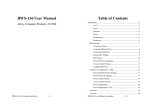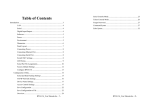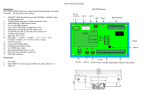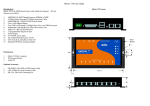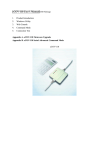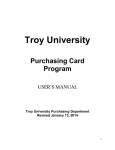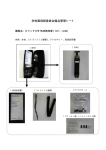Download SE-110S User Manual
Transcript
Table of Contents
1
Introduction ............................................................................................ 2
Connecting Power....................................................................... 8
Introduction
Connecting Ethernet Port............................................................ 8
Connecting Serial Port ................................................................ 8
Switch SW1 Settings .................................................................. 8
Factory Default Settings ........................................................... 10
Overview
Configure SE-100M-EV ........................................................... 11
Install Java Configuration Utility...................................................... 12
The SE-110S is a stand along Serial-to-Ethernet embedded module
Serial and Data Packing Settings .............................................. 14
which adds network and Web server function for
TCP/IP Network Settings.......................................................... 14
legacy RS-232/422/485 devices. The SE-110S provides a
Device Name Settings............................................................... 15
transparent data channel between serial device and the
Access Control Settings ............................................................ 15
TCP/IP network, so that the serial device can be accessed by
Save Configuration ................................................................... 17
using standard TCP/IP protocols. The SE-110S can behave as
Save Configuration to File ........................................................ 17
a TCP server, a TCP client or an UDP node on a Ethernet
Overview .......................................................................................... 19
network to fulfill versatile application requirements.
Overview .......................................................................................... 21
Serial Console Mode................................................................. 21
Programmable Digital I/O
Telnet Console Mode................................................................ 22
Besides, the SE-110S also provides 4 TTL digital
Forgot Password ....................................................................... 23
I/Os. A pre-defined ASCII command set is provided for users
Command Syntax...................................................................... 23
to control these I/Os through LAN/WAN.
Echo Syntax .............................................................................. 28
SE-110S User Manual
-1-
SE-110S User Manual
-2-
Power consumption: 100mA@+5VDC
Product Specifications
Operation temp.: 0~70C, 5~95% RH
Storage temp.: -20~85C, 5~95% RH
Warranty: 2 years
Form Factor
Type: stand alone module with pin header connector
WxLxH: 57x40x15 mm
Network Interface
Type: 10/100BaseT, auto-detect
Protocols: TCP, UDP, HTTP, Telnet, IP, ICMP, ARP
IP addressing: DHCP, Static IP
Operation Modes
TCP/Server, TCP/Client and UDP mode
Serial Interface (TTL-level)
Signals: TxD, RxD, RTS, CTS, DTR, DSR, DCD, GND
Baud: 1,200 to 38,400 bps
Parity: None, Even, Odd
Data bits: 7,8
Stop bit: 1,2
Flow control: None, RTS/CTS, XON/OFF
Programmable Digital I/O
PIO0~PIO3: TTL level compatible
Configuration Methods
Web console, Telnet Console and Serial Console
Windows utility (included in CD)
General
Power input: 5VDC
SE-110S User Manual
-3-
SE-110S User Manual
-4-
SE-110S User Manual
-5-
SE-110S User Manual
-6-
2
Getting Started
Connecting Power
Connecting +5VDC power line to pin 11 or 13 and ground to pin
12 to 14 of J2 connector.
Connecting Ethernet Port
Connect a RJ45 Ethernet cable to the Ethernet port of SE-110S.
The 10M_LED or 100M_LED pin will be output of CMOS high
signal to show the network speed if Ethernet cable is corrected to
the network.
Connecting Serial Port
Use CBL-F10M9-20 10-pin to DB9 serial cable to connect J1 of
SE-110S.
The CBL-F10M9 can be purchased separately from
Artila or home made by user. The serial port (J1) is a standard
RS-232 serial port. (line driver is included)
SW1 Pin Setting
SE-110S User Manual
-7-
Connecting SW1 pin to ground will force SE-110S to enter serial
SE-110S User Manual
-8-
console mode. In serial console mode, user can use text
command to configure SE-110S.
command are described in Command Syntax section.
Please refer to the command
syntax section for the information to configure SE-110S
Factory Default Settings
In serial console mode, Ready pin signal will flash high and low
and the Ethernet function will be disabled.
All the new
The factory default settings are:
configuration will be effective after the next system boot.
IP Address: 192.168.2.127
Data Port: 4000 (configurable)
Reset Pin Setting
Telnet Port: 5001
Web Port: 80
To implement a hardware reset button, user can simply connect
Baud rate: 19200
Reset pin and Ground pin with a push button.
Data Format: N,8,1 ( Parity, Data bits, Stop bits)
Flow Control: None
Interface: RS-232
Ready Pin Setting
When SE-110S firmware is ready, the Ready signal will be an
output of TTL level high
PIO Pin Setting
DIO0 to DIO3 are TTL compatible Programmable DIO. All the
DIO channel are internally pulled up to +5VDC with a 4.7K Ohm
resistor.
The DIO can be controlled by Telnet Console or Serial Console and
SE-110S User Manual
-9-
SE-110S User Manual
- 10 -
3
Configure SE-110S
Java Configuration
SE-110S provides four ways to configure the settings. They are:
1.
Java Configuration Utility
2.
Web Configuration Utility
3.
Serial Console
4.
Telnet Console
Install Java Configuration Utility
To install the Java Configuration Utility, you can simply copy
manager.jar to the desired folder. Double click on the icon will
To use the Java configuration utility software, you need to
start the manager.jar
install the Java 2 Platform, Standard Edition (J2SE) version
1.4.2 or later.
J2SE is free and available at
http://java.sun.com
Once this program started, it will perform a broadcast search to
find the SE-110S device in the network. If you cannot find the
SE-110S module and you know the IP address of the module, you
SE-110S User Manual
- 11 -
can click Search by IP item and specify the IP address to find the
SE-110S User Manual
- 12 -
SE-110S. The default IP address of SE-110S is 192.168.2.127.
Serial and Data Packing Settings
Click on the row of the SE-110S settings, the configuration
window will open as follow:
The group of setting is to configure the serial interface and data
packing settings. Data Packing setting is are as follow:
Length: Pack the length of serial data before forwarding data to
Ethernet port
Timeout: the period of time to forward data to Ethernet Port
Delimiter: Wait for the Delimiter Character before forwarding
data to Ethernet port.
The Delimiters are maximum two bytes
Hex format ASCII code. If you use Carriage Return (CR) and Line
Feed (LF) as delimiters, you can specify 0D0A or 0d0a.
TCP/IP Network Settings
The group of TCP/IP Network settings are configuring the IP
Address, TCP port and operation mode as follow:
OpMode: TCP operation mode setting
TCP Port: TCP Port number of SE-110S
Destination IP: The IP address of remote host which SE-110S
When the SW1 is set to Console mode, SE-110S cannot be
will actively connect to (TCP Client mode only)
discovered by the Configuration Utility and
Connect At: Startup means TCP connection is established when
the configurations are controlled by serial console.
system starts (TCP Client mode only)
Timeout: When this option is checked, TCP connection will be
When enter the configuration mode, the READY signal will be
disconnected if there is no serial data activity before timeout
flashing high and low and TCP Data Port will be disabled and data
IP Mode: Configure the IP Address to be Static IP or Dynamic IP
transfer between serial port and Ethernet port will be stopped.
SE-110S User Manual
- 13 -
by DHCP
SE-110S User Manual
- 14 -
IP Address: Set the Static IP Address
Subnet Mask: Subnet Mask setting
Gateway: Gateway address setting
Device Name Settings
Click Edit Device Name button can edit the device name
Access Control Settings
Enable IP Filtering: When this option is checked, user can
SE-110S provides IP address filtering method and password
specify the starting IP address and ended IP address which are
authentication for access control
allowed to access SE-110S TCP port in order to prevent
unauthorized access.
Password Settings: Enter the new password will enable the
password authentication. Password is required to login Java
Configuration and Web configuration Pages in the next entry.
SE-110S User Manual
- 15 -
SE-110S User Manual
- 16 -
Save Configuration
The configuration is a text file and uses extension of txt. If you use
Text editor to open the configuration command, you will notice that
After the all the settings are configured, click to the Save to
the configuration file contains the ASCII command set of the
Module button to save the settings to the module. The new
configuration.
settings will be effective after the reboot of module by clicking the
editor to configure the settings and import it to the SE-110S by using
Reboot Module button. If the IP address had been modified,
the Import button.
You can also edit these commands by the text
please do broadcast search or search by IP again to find the
SE-110S module.
Save Configuration to File
You can also save current configuration to file by click the Save to
File button. A new window to specify the path of the file will pop
out as follow:
SE-110S User Manual
- 17 -
SE-110S User Manual
- 18 -
4
Web Configuration
Overview
SE-110S can also be configured by Web Browser.
The build-in
Web server and Web configuration pages makes SE-110S
configurable anywhere via a Web browser such as IE and Firefox.
To open the Web configuration pages, you can simply type the IP
address to the Web Address input such as 192.168.2.127. The
The configuration is very similar to the Java configuration utility.
Login windows will ask you enter password if the password option
After completing the settings, click submit button then all the
is enabled. After password confirmed, the web configuration
settings will save to the module and the module will reboot
page will show up as follow:
automatically to use the new configuration.
SE-110S User Manual
- 19 -
SE-110S User Manual
- 20 -
5
Serial/Telnet Command
Interface: RS-232
Now you can use serial terminal software to send the ASCII
command to SE-110S.
In Serial Console Mode, all the network functions will be
disabled
Overview
Once the configuration is completed, remember to disconnect SW1
SE-110S provides a set of ASCII command to configure it through
to ground and reboot the module by Reset Command or push reset
a serial and Ethernet port. User can use serial terminal or Telnet
button.
command to configure SE-110S when Web browser and Java
utility are available. In addition, these functions provide user the
most convenient way to develop their own configuration utility
Telnet Console Mode
software simply to use the ASCII command.
SE-110S uses Port number 5001 as telnet console port.
Remember to turn on the LOCALECHO before opening the telnet
Serial Console Mode
console port. You must login first before sending command to
To enter the Serial console mode, you need to short SW1 signal to
SE-110S. If password is enabled, you need to use the password
ground and then serial port will function as a console port. The
to log in. The password is encrypted using Tiny Encryption
READY signal will keep flash that indicates SE-110S is in serial
Algorithm (TEA) and the keys are sixteen bytes with low case
console mode. Please set the serial data setting of the Serial
character from “a” to “p”. The login command format is as
Terminal software (such as Hyper Terminal) to be the same as the
follow:
$LOG[16 bytes of TEA Encrypted Password]
SE-110S serial port.
or
$LOG
Baud rate: 19200
if there are no password settings
Data Format: N,8,1 ( Parity, Data bits, Stop bits)
Flow Control: None
SE-110S User Manual
- 21 -
SE-110S User Manual
- 22 -
Forgot Password
Command
If you forgot the Password, you can switch SW1 to Factory Default
setting mode and use default IP Address 192.168.2.127 and enter the
R
Category
Basic
Web console pages. Once the configuration is completed,
G
S
G
remember to switch SW1 back to Normal operation mode and
S
reboot the module by Reset Command or push reset button.
Password is not required for serial console mode.
W
Serial
G
Parameters
(2 bytes)
(command related)
BN: Device Name
Max. 14 bytes
BM: Model Name
Default
BP: Password
BV: Firmware ver...
G
Therefore you
Function
S
Max. 8 bytes
Default
SB: Baud Rate
1200
can also use serial console to reset the password.
2400
4800
9600
Command Syntax
19200
38400
The command syntax is
G
S
[Delimiter][Command][Carriage Return/CR][Line Feed/LF]
SD: Data Format
N72
(Parity,Data,Stop)
E71
Delimiter (one byte): The command begins with a delimiter of
O71
dollar sign $ and if SE-110S receives the correct command it will
N81
response with an echo which begins with the delimiter of a
E72
percentage sign %.
O72
Command: The command are ASCII string which contains three
E81
elements: {Read/Write}{Function}{Parameter} as described as
O81
follow:
N82
G
S
SF: Flow Control
NONE
RTS/CTS
XON/XOFF
G
SE-110S User Manual
- 23 -
S
SI: Interface
RS-232
SE-110S User Manual
- 24 -
Network
RS-422
[1]: Timeout Option
RS-485
[2]: Length Option
G
S
LI: IP Address
e.g. $SLI192.168.2.127
}={1:Enable,0:Disable}
G
S
LN: Netmask
e.g.$SLN255.0.0.0
e.g. $SOD110
G
S
LG: Gateway
e.g. $SLG192.168.2.254
G
S
LC: IP Mode
G
S
OS: Delimiter
e.g. $SOS0D0A (CR/LF)
0: Static IP
G
1: DCHP
G
LM: MAC
Default
G
LS: LAN Status
Link fail
Max. two bytes characters
S
OT: Timeout
0~65535
(unit: ms)
e.g.$SOT500
G
Link OK,100M
S
OL: Data Length
0~1024
e.g.$SOL20
Link OK, 10M
G
S
LW: TCP windows
0:128, 1:256, 2:512,
size
3:1024
Access
G
S
OM:
Operation
Mode
G
S
S
OF:IP Filtering
OC: TCP connection
OU: Timeout clock
G
S
OI: Authorized IP
168.2.180 (Starting IP:Ended
128 bytes
IP)
TS:TCP Server
TCP Server
G
S
VP: Listen Port
OD: Data Packing
1~65535
e.g. $SVP4000
TCP Client
G
S
CI: Destination IP
e.g.$SCI192.168.1.211
TO: Disconnect if
G
S
CP: Destination Port
e.g.$SCP4001
timeout
G
S
CC: Connection
0: Reserved for PPPoE
Logic
1:Establish connection when
AC: always connect
0~65535
Serial Data in
e.g. $SOU500
S
e.g.$SOI192.168.2.127:192.
means TCP window size
(unit: ms)
G
0: Disable
1:Enable
TC:TCP Client
timeout option
G
S
Control
e.g. $SLW0
Operation
G
System
S
YC: System mode
R: Reboot system
Three parameters:{
F: Reset to default setting
[0]:Delimiter Option
and reboot
SE-110S User Manual
- 25 -
SE-110S User Manual
- 26 -
DIO
D: Set current setting as
e.g. $GDI:4
Default setting
Get DIO4 status
Remark: Italic font stands for Command String
S
EI: Exit console
S
DM: Set Digital I/O
I: Input
mode
O: Output
CR/LF (two bytes): Both command from host and echo from
e.g. $SDMI:0,4,5
SE-110S are terminated with a Carriage Return (ACSII code Hex
set DIO0, DIO4, DIO5 as
0d) and Line Feed (ASCII code Hex 0a). Therefore please
input
remember to add CR/LF at the end of command line in the terminal
emulation program.
$SDMO:1:H,2:L,3:H
set
DIO1,DIO2,DIO3
as
output and initial state are
All command strings are in Upper Case
High (H) or Low (L)
DM:
G
Get
Digital
I/O mode
S
DOH:
Echo Syntax
e.g. $GDM
the response is
Set
DO
%GDM I,O,O,O,I,I,O,O
After SE-100M-EV console port received correct command string,
e.g. $SDOH:1,3,7
it will response Echo String and the Echo Syntax is as follow:
[Delimiter][Function][Status]
channel High Output
S
DOL:
Set
DO
Delimiter (One byte): A percentage sign “%”
e.g. $SDOL:2,6
Function (Two bytes): function string
channel Low Output
G
Status: “OK” or “FAIL”
e.g. $GDO:2
DO:X
get DIO2 status
G
DI: Get DI channel
e.g. $GDI
status
the response is
For example: Set the IP Address by sending command
$SLI192.168.2.125(CR)(LF)
%GDI 0=1,4=0,5=1
%SLIOK(CR)(LF)
It stands for
DIO0=1,DIO4=0,DIO5=1
SE-110S User Manual
Echo string
- 27 -
means the new IP address is successfully transferred to the module
and the new setting will be effective after reboot the module.
SE-110S User Manual
- 28 -
To get IP address setting, you can send a command as follow
$GLI
Appendix A
then the Echo string will be
%GLI192.168.2.125
Tiny Encryption Algorithm
Always remember to reboot the module by send command
1.
Example of TEA.C
$SYCR to use the new configuration
/************************************************
The Tiny Encryption Algorithm (TEA) by David Wheeler and Roger Needham of the
Cambridge Computer Laboratory. Placed in the Public Domain by
David Wheeler and Roger Needham.
**** ANSI C VERSION (New Variant) ****
Notes:TEA is a Feistel cipher with XOR and addition as the non-linear mixing
functions.
Takes 64 bits of data in v[0] and v[1]. Returns 64 bits of data in w[0] and w[1].
Takes 128 bits of key in k[0] - k[3].
TEA can be operated in any of the modes of DES. Cipher Block Chaining is, for
example, simple to implement. n is the number of iterations. 32 is ample,
16 is sufficient, as few as eight may be OK. The algorithm achieves good
dispersion after six iterations. The iteration count can be made variable if
required.
Note this is optimised for 32-bit CPUs with fast shift capabilities. It can very
easily be ported to assembly language on most CPUs. delta is chosen to be the
real part of (the golden ratio Sqrt(5/4) - 1/2 ~ 0.618034 multiplied by 2^32).
This version has been amended to foil two weaknesses identified by David A.
Wagner ([email protected]): 1) effective key length of old-variant TEA was
126 not 128 bits 2) a related key attack was possible
SE-110S User Manual
- 29 -
SE-110S User Manual
- 30 -
although impractical.
}
************************************************/
2.
//#include "xtea.h"
#ifndef __XTEA_H__
void encipher(unsigned long *const v,unsigned long *const w,
#define __XTEA_H__
const unsigned long *const k)
void encipher(unsigned long *const v,unsigned long *const w,
{
const unsigned long *const k);
register unsigned long
y=v[0],z=v[1],sum=0,delta=0x9E3779B9,n=32;
while(n-->0)
The TEA.H
void decipher(unsigned long *const v,unsigned long *const w,
const unsigned long *const k);
{ y+= (z<<4 ^ z>>5) + z ^ sum + k[sum&3];
#endif
sum += delta;
z+= (y<<4 ^ y>>5) + y ^ sum + k[sum>>11 & 3];
}
w[0]=y; w[1]=z;
}
void decipher(unsigned long *const v,unsigned long *const w,
const unsigned long *const k)
{
register unsigned long
y=v[0],z=v[1],sum=0xC6EF3720,
delta=0x9E3779B9,n=32;
/* sum = delta<<5, in general sum = delta * n */
while(n-->0)
{
z-= (y<<4 ^ y>>5) + y ^ sum + k[sum>>11 & 3];
sum -= delta;
y-= (z<<4 ^ z>>5) + z ^ sum + k[sum&3];
}
w[0]=y; w[1]=z;
SE-110S User Manual
- 31 -
SE-110S User Manual
- 32 -
















